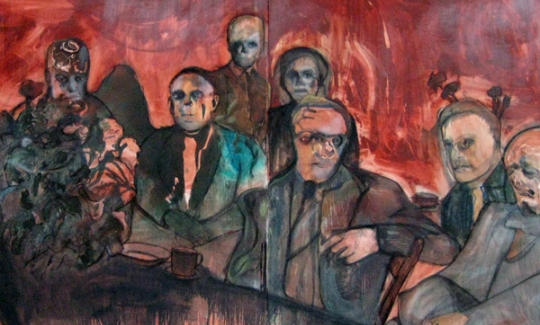Curator: Tal Yahas
Maya Bloch's paintings focus on the depiction of human figures - group portraits in round-the-dinner-table scenes - alongside single portraits of women, some in a forest environment. Anna Veronica was the original, now almost forgotten, name of Bloch's mother, before she was granted a new, Hebrew one, upon her arrival in Israel at the age of five. Its employment does not point to a preoccupation with the artist's biography, but vice versa - to a kind of metaphorical ghost symbolizing for her the possibility of otherness to inhabit a familiar space and the possibility of melding real and fictional biographies. This doubling is expressed in the way Bloch produces the subjects of her portraits, which are based on photographs she culls from newspapers, other people's family albums and the internet; she "harasses" these family photographs and "imports" them into her own world, in this way resuscitating unknown identities and making up other people's emotional worlds. But even though she relates to the photographs' characteristics by borrowing their compositions, she does not search for a realist context but rather dredges up the dark psychic situations that lie behind the photographed figures' representational "poses."
In the passage between the anonymous and the intimate, between photograph and painting, Bloch seems to peel away the figures' layers of "normality," inherent to the photographs' mundane veneer. The figures themselves undergo a kind of "wearing out" or effacing procedure, rendering them tormented and distorted; their bodies - usually asexual in nature - are often severed from their faces and blurred like ghosts'. A great gloom permeates the works, and the figures' faces show signs of distress. The narrative source of this malaise is generally not revealed through the images themselves, remaining a kind of general mood of sadness and loneliness - a feeling which grows even more palpable in the collective scenes which supposedly symbolize the sociality of a circle of friends or the family. An atmosphere of tension, anxiety and suffocation permeates these scenes, in which the figures seem self-absorbed, sharing no interrelations or communication. The figures' communication difficulties and their troubled silence are well visible in the depiction of their mouths, most of which are closed, effaced or hidden. Their stifled silence, which harbors complex psychic mechanisms, present the figures distorted with the force of that repression. But despite the general air of gloom, the works also exhibit a light touch of black humor. The artist's gaze exposes her subjects in all their vulnerability, but simultaneously reflects identification, and above all compassion.


